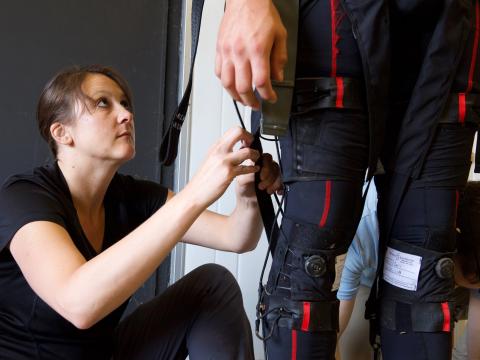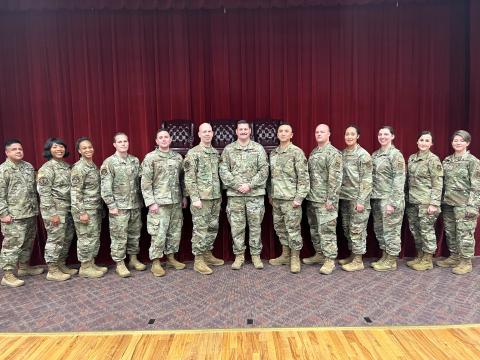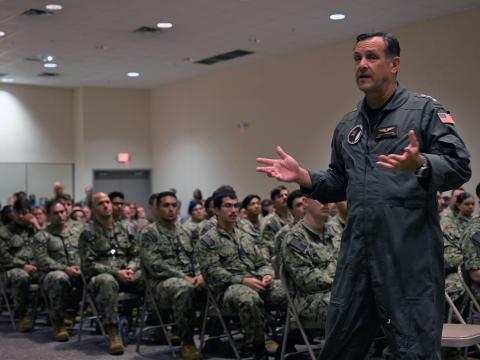Demonstrations Focus on Coalition Communications
Need for seamless network connectivity grows as federal agencies face increasing cooperative efforts.
The U.S. military will conduct its annual search for interoperability solutions next month with a renewed sense of urgency as nations continue to pull together to fight terrorism and government agencies pursue collaboration in homeland security efforts. Once again, this year, the focus will be on examining dozens of technologies that commands can employ to address immediate interoperability problems.
With a theme of “Coalition Interoperability, the 21st Century Warfighter’s Environment,” the Joint Warrior Interoperability Demonstration (JWID) 2003 will explore the potential of technologies that meet the military’s operational requirements. The recent reorganization of U.S. government departments expands the definition of the term coalition, however. Traditionally, the term has been used primarily to describe a group of nations. But as the need for government agencies to share information increases, law enforcement, intelligence and emergency organizations also are potential coalition partners. The constituents may be different, but the requirement to collaborate is the same.
The chairman of the Joint Chiefs of Staff sponsors JWID. For the first time since the demonstrations began in the 1980s, the Defense Information Systems Agency (DISA), Arlington, Virginia, will be the lead organization of JWID. In the past, management of the event rotated among the services.
For the second consecutive year, the U.S. Pacific Command, Camp Smith, Hawaii, will be the host command. Additional participating sites include the Naval Surface Warfare Center, Dahlgren, Virginia; the Space and Naval Warfare Systems Center, San Diego; and the Electronic Systems Command, Hanscom Air Force Base, Massachusetts. The National Imagery and Mapping Agency, Washington, D.C., will provide scenario charting, mapping and geodesy support, including multispectral imagery. The National Security Agency will perform security assessments of the technologies.
Lt. Gen. Harry D. Raduege Jr., USAF, director, DISA, notes that the management change will contribute continuity to the event. “When we went to each service as part of a shared responsibility, it was a learning experience each time one of the services had to pick it up again. Every fourth or fifth year, you’ve lost a lot of people who have transferred out, and some people have transferred in. Some of the continuity of experience and understanding is lost in the all-important planning phase of JWID,” Gen. Raduege says. DISA was a natural fit because it is a joint organization and a combat support agency, he adds.
Since its beginning, the event has evolved to address changing requirements. Prior to JWID 2002, the demonstration took place biennially. During the first year, each technology demonstration was evaluated, and a few technologies were chosen as gold nuggets, which were further exploited during the second year. These were made available to combatant commands for purchase. Last year, this approach was abandoned. Instead, every demonstration was evaluated, but gold nuggets were not chosen.
Lt. Col. Charles A. Adams Jr., USAF, director, JWID Joint Management Office, DISA, explains that the two-year cycle sometimes got in the way of inserting the solutions into the forces because new combatant commanders were not invested in the gold nuggets. “So who’s maintaining the longevity and long-term life cycle on those products? Nobody is. It then drops on the next combatant commander who looks at it and says, ‘Now, do I keep it or not?’ And a year from then, they find a new product. So we saw that it detracted from the primary focus, which was going out for interoperability solutions,” Col. Adams says. Gen. Raduege adds that the two-year cycle for information technology, which changes so quickly, also posed challenges.
For JWID 2003, U.S. and international forces will investigate command, control, communications and computer (C4) solutions that focus on six core objectives. “JWIDs always start out with operational objectives. It is not just a technology demonstration or technology expo. It has a focus to it. This year, one of the major goals is coalition information sharing. And frankly, as I go around and talk with all the combatant commanders, that is one of the hot topics with most of them these days—getting solutions to problems they have in talking with their coalition partners,” Gen. Raduege says. Some combatant commanders have bilateral-type arrangements with many partners, some as many as 40 or 50 nations, such as U.S. Central Command today, he adds.
The general points out that coalitions are different today for the military. “We have it in our mind that coalition means another foreign government. But we have some areas now where coalition for certain of our combatant commands means working an alliance with other federal government activities of the United States. I specifically point to U.S. Northern Command, a brand new command, that now has a coalition that Gen. [Ralph] Eberhart [USAF, commander, North American Aerospace Defense Command, and commander, U.S. Northern Command] has to put together based on any situation for homeland defense,” he says. In addition to foreign nations that the command must work with for homeland security, today it must lash together federal agencies that traditionally do not use U.S. Defense Department systems.
For example, the Northern Command was called on to help in the space shuttle Columbia emergency and formed a coalition of federal agencies. It had to determine which organizations were necessary to respond to the disaster and needed collaborative planning and videoconferencing capabilities to plan the response, Gen. Raduege offers.
In this and other situations, the command must put together a coalition on-the-fly. “With the Columbia disaster, it was NASA-centric. The next disaster could be Department of Energy-centric. The following one could be Department of Transportation-centric, with a whole different set of players who are not tied together over Department of Defense networks,” Gen. Raduege explains. Coincidentally, the Northern Command is scheduled to host JWID 2004. The focus will be on these types of alliances, and the management office is looking for another combatant command that would examine corresponding warfighter issues, Col. Adams adds.
Although the Pacific Command is hosting JWID for the second consecutive year, some changes will be apparent. In 2002, Pacific Rim nations were in a separate room, isolated electronically from the U.S. team. Col. Adams explains that this year they are part of the multinational task force staff supporting the host combatant command. Next year, they may have an electronic link to their national command and control system, but discussions about this next step are still underway, the colonel allows.
Interoperability continues to be a challenge despite ongoing work. In many cases, problems have been acknowledged, standards established and technology solutions identified. The Joint Interoperability Test Command (JITC) tests and certifies any communications capability that the Defense Department adopts. “Realistically, you can say that anything that will be plugged into a DOD network should be certified by the JITC. But people trying to solve their own problems will, quite often, be presented with technologies from vendors to solve a specific problem. A lot of times it will solve the problem for that particular service or activity, but it is not built to be interoperable with other people who may need to share that information. That’s what everybody’s talking about when they say ‘building stovepipes.’ And we can’t be building stovepipes, but it happens because people will see a problem that they want to solve,” Gen. Raduege offers.
JWIDs have produced solutions that currently are in use, such as the Distributed Collaborative Tool Suite. “Perhaps, even more importantly,” the general shares, “JWIDs in the past prevented a lot of stovepipes from entering into inventory because they didn’t pass the test.”
More than 40 coalition interoperability trials (CITs) will be examined at the various sites, and some will be assessed at more than one site. Depending on the CIT, the evaluation may include warfighter, technical and security assessments.
The trials are divided into nine functional areas. Six will address multilevel security services, and seven will deal with common operational picture command and control systems. Collaboration capabilities and language translation services will be the focus of six technologies, and geospatial intelligence and imagery services will be addressed by seven demonstrations. Two trials will illustrate military messaging and directory services, and one will examine logistics. Network management and intrusion detection/analysis services are the topic of seven demonstrations, and three air mission-planning trials will take place. Finally, communications and mission-support applications are the subject of seven CITs.
These industry-proposed demonstrations meet at least one of the six objectives outlined by the event’s organizers. The first objective is to provide technical solutions that improve information sharing among nations given the requirements for multiple levels of security and different combinations of access specifications. Finding solutions for sharing information among different nations’ logistics systems to support the planning and execution of operations is the second objective. The multilingual environment of coalition operations requires assistance with language barriers. JWID’s third goal addresses this issue as it seeks real-time or near-real-time language translation tools to enable more effective coalition operations.
The demonstration’s final three objectives focus on the coalition network. The fourth objective is to examine methods of sharing situational awareness information with nations via coalition networks. The fifth objective is to define a minimum set of capabilities and procedures required to establish a coalition network vulnerability assessment capability. Finally, objective six is to determine and validate core network services solutions for implementation on operational coalition networks.
Coalition participants include Australia, Canada, New Zealand, the United Kingdom and some NATO nations. In addition, the Pacific Command has invited Japan, Singapore, South Korea and Thailand to participate as coalition task force members in the scenario.
JWID is conducted in a simulated operational environment as the context for warfighter validation of C4 solutions. Event organizers design a scenario of fictitious nations facing one or more problems that must be resolved. Participants use the trial technologies to conduct missions, which allows them to evaluate effectiveness.
The demonstration is conducted over the Combined Federated Battle Laboratories Network. One key objective for JWID 2003 is to investigate how to provide multiple levels of security on the network.
Like information security, products must be born interoperable, Gen. Raduege points out. To industry, he offers this advice. “Please try to develop products that have interoperability in mind, and do not present us with proprietary solutions that we are then tied to or that will delay our progress. Instead of trying to bolt it on later on, build it in at the beginning.
“Best value comes from best capabilities and with best price, then we’ll choose the best value capabilities for our Department of Defense,” he says. “The interoperability and the security have to be there from the beginning, and the best ones to build it in from the beginning are our industry partners.”
Gen. Raduege says he hopes that JWID will continue to move forward in discovering solutions for the operational commanders. He wants the combatant commanders and the chairman of the Joint Chiefs of Staff to be satisfied that JWID is a value-added activity. “This JWID is supposed to be a sounding board for a combatant commander to be able to stress an operational requirement and then allow somebody, through the JWID process, to come up with solutions that are injected into that process by industry,” he says.
The general says he would be disappointed if JWID misses the mark or wastes money. “Time, effort and money are absolutely precious. My worst nightmare is that we would not be meeting the requirements of the combatant commanders in what they’ve asked us to do, that we have let them down and failed to accomplish our mission of putting together an interoperability demonstration with ideas that come out the end of the chute to solve their problems,” he says.



